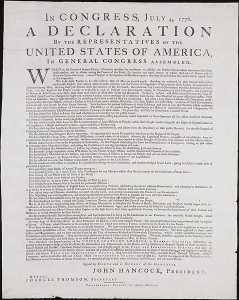
As you fire up the BBQ and ready your fireworks, you should realize you are technically not celebrating “independence,” but celebrating the Declaration of Independence. Here’s why.
The day the founding fathers voted to approve the resolution for independence was actually July 2nd, 1776. On that day, Americans agreed to kiss the Crown goodbye. (They didn’t agree unanimously–note how that word is missing on the above image–until July 15th though, because it took New York a while to agree to the resolution.) After July 2nd, came the drafting of a formal declaration which Congress debated and edited for a couple of days. By the time they had approved the document, it was July 4th. That’s the date that appeared on the first printed copies of the Declaration, also known as “broadsides.” (A sheet of paper printed on one side.) There were about 200 or so of those printed by John Dunlap of Philadelphia.
All along we’ve celebrated independence on July 4th, because that’s the date the public first saw printed on the broadsides. There were no signatures on these copies, because they were typeset. The big Declaration of Independence, the parchment most of us recognize with the signatures at the bottom, didn’t come until later.
As for those original 200 broadsides, there were 24 known copies up until 1989. Then a painting was bought for $4 at a flea market for the frame. Behind the canvas was a 25th copy. It sold for $2.4 million. A 26th copy was “found” in the National Archives is Kew, England in 1990.
1 Comment on July 4th: Not Independence Day
Comments are closed.

Incredible. Thanks so much for sharing this story.